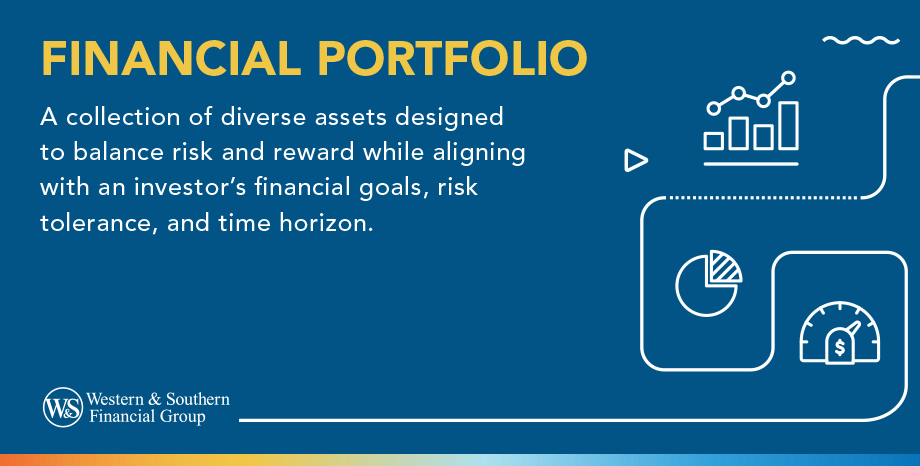Table of Contents
Table of Contents


Key Takeaways
- A financial portfolio is a mix of assets, including stocks, bonds, real estate, and cash, designed to balance risk and reward.
- Diversification can help reduce the overall volatility of a portfolio.
- Risk tolerance influences portfolio composition, with conservative investors favoring bonds and cash while aggressive investors allocate more to stocks and real estate.
- Regular rebalancing is essential to maintain asset allocation, adjust for market fluctuations, and keep investments aligned with financial goals.
- Tax-efficient investing can maximize returns, with tax-advantaged accounts like 401(k)s and IRAs reducing tax liabilities over time.
What Is a Financial Portfolio?
A financial portfolio consists of a mix of financial assets designed to generate returns while managing risk. It can include stocks, bonds, real estate, mutual funds, cash investments, and alternative investments. The composition of an investment portfolio depends on an individual’s financial goals, risk tolerance, and investment time horizon.
The goal of a portfolio is to balance risk and reward. A well-diversified portfolio helps manage exposure to market volatility and supports long-term financial confidence.
Why is a Financial Portfolio Important?
A well-structured financial portfolio is important for long-term security, income generation , and capital preservation while managing risk. Diversification across asset classes can help reduce the overall volatility of a portfolio potentially ensuring stability in various economic climates.
Investors can align portfolios with their investment goals and risk tolerance by grasping investment performance, costs, and strategic allocation. Active management allows individuals to optimize returns and adapt to changes in their financial circumstances or market conditions.
Key Components of a Financial Portfolio
A robust financial portfolio is comprised of various asset classes, with each playing a distinct role:
Stocks and Equities
Stocks represent ownership in a company and offer the potential for capital appreciation. They are considered higher-risk investments due to market fluctuations but provide long-term growth potential. Stocks are a key component of aggressive portfolios that seek higher returns.
Bonds and Fixed-Income Investments
Bonds are debt securities issued by governments or corporations that pay periodic interest. They provide stability and income, making them a crucial component of a well-balanced portfolio that includes both equity and fixed-income investments.
Cash and Cash Equivalents
Holding cash investments, money market accounts, or certificates of deposit (CDs) helps provide liquidity and security. While they offer low returns, they help ensure funds are available for emergencies or short-term expenses.
Real Estate and Alternative Investments
Real estate investments, commodities, hedge funds, and private equity can diversify a portfolio and hedge against inflation. These investments often require more capital and have less liquidity than traditional stocks and bond funds.
Mutual Funds, ETFs, and Index Funds
These investment vehicles allow investors to diversify their portfolios without selecting individual investments. Index funds and ETFs provide low-cost exposure to broad market benchmarks, while mutual funds may offer actively managed options overseen by fund managers.
Steps to Build a Strong Financial Portfolio
Building a strong financial portfolio is key to helping ensure your financial future. Consider collaborating with a licensed financial advisor to tailor a portfolio that aligns with your goals and aspirations.
Step 1: Define Your Financial Goals
Before building a portfolio, determine your investment objectives. Are you investing for a retirement goal, wealth accumulation, or a college savings goal? Your goals will influence your asset allocation and risk tolerance.
Step 2: Assess Your Risk Tolerance
Risk tolerance varies by investor. A conservative investor may prefer bonds and cash investments, while an aggressive investor may allocate more funds to stocks and real estate. Understanding your comfort with investment risk helps shape a portfolio that suits your needs.
Step 3: Diversification Strategies
Diversification reduces risk by spreading investments across a variety of asset classes. A well-diversified portfolio might include a mix of domestic and international stocks, bonds, real estate, and alternative assets. This approach can help reduce the overall volatility of the portfolio.
Step 4: Selecting Investment Vehicles
Investors can choose between active and passive investing strategies. Active investing involves selecting individual investments and adjusting the portfolio frequently, while passive investing relies on index funds and ETFs to track broad market benchmarks.
Step 5: Considering Tax Implications
Investing in tax-advantaged accounts, such as 401(k)s and IRAs, can reduce tax liabilities. Tax-efficient investing, like holding dividend-paying stocks in tax-advantaged accounts, helps maximize returns and minimize transaction costs.
Managing & Rebalancing Your Portfolio
Regularly reviewing your portfolio is crucial for securing your financial future. Here are several strategies to effectively manage and rebalance your investments.
Monitoring Investment Performance
Regularly reviewing your portfolio helps ensure that investments align with your financial goals. Tracking returns and market conditions helps identify underperforming assets and help ensure that your preferred asset allocation remains intact.
Rebalancing Strategies
Over time, market fluctuations can shift the balance of your portfolio. Rebalancing involves selling overperforming assets and buying underperforming ones to maintain your desired asset allocation. Strategic asset allocation guidance can help investors navigate changes in their investment portfolio over time.
Managing Market Fluctuations
Investors often react emotionally to market downturns, leading to panic selling. Staying focused on long-term goals and avoiding impulsive decisions is important for portfolio success, especially in different stages of life related to financial planning.
Working With Financial Professionals
Some investors manage portfolios independently, while others seek financial advisors or robo-advisors for guidance. Professional advice can help optimize asset allocation and improve investment decisions at different life stages, from saving for college tuition to planning for late retirement.
Common Mistakes to Avoid
Crafting a financial portfolio necessitates meticulous planning. Steer clear of these prevalent pitfalls.
- Lack of diversification – Investing too heavily in one asset class increases risk.
- Ignoring risk tolerance – Investing beyond your comfort level can lead to emotional decision-making.
- Overtrading and emotional decision-making – Frequent buying and selling can erode gains and increase transaction costs.
- Neglecting tax efficiency – Failing to use tax-advantaged accounts can reduce long-term returns.
- Not reviewing and rebalancing regularly – Market changes can shift portfolio allocation, requiring periodic adjustments.
- Lack of clear goals -Investors often fail to build successful portfolios due to unclear goals, but setting SMART objectives can align strategies with aspirations.
- Overreacting to market volatility - To capitalize on recovery in volatile markets, keep a long-term focus and adhere to your investment strategy of reacting impulsively to emotions.
- Not following the stock market trends - Ignoring stock market trends can hurt your portfolio; therefore, it's important to track market movements, economic, and sector performance to improve your investment strategies and growth potential.
Final Thoughts
A well-structured financial portfolio with your goals and risk tolerance. You can support long-term success by diversifying assets, monitoring performance, and rebalancing as needed. Regular reviews and informed decisions promote growth and stability, whether planning for retirement or saving for a child's college. Grasping investment costs and maintaining a balanced risk approach can help you achieve your financial objectives effectively.
Strengthen your financial portfolio and start planning today. Invest In My Future
Frequently Asked Questions
What are conservative investments?
Footnotes
- Diversification does not ensure a profit and does not protect against a loss in declining markets.





















